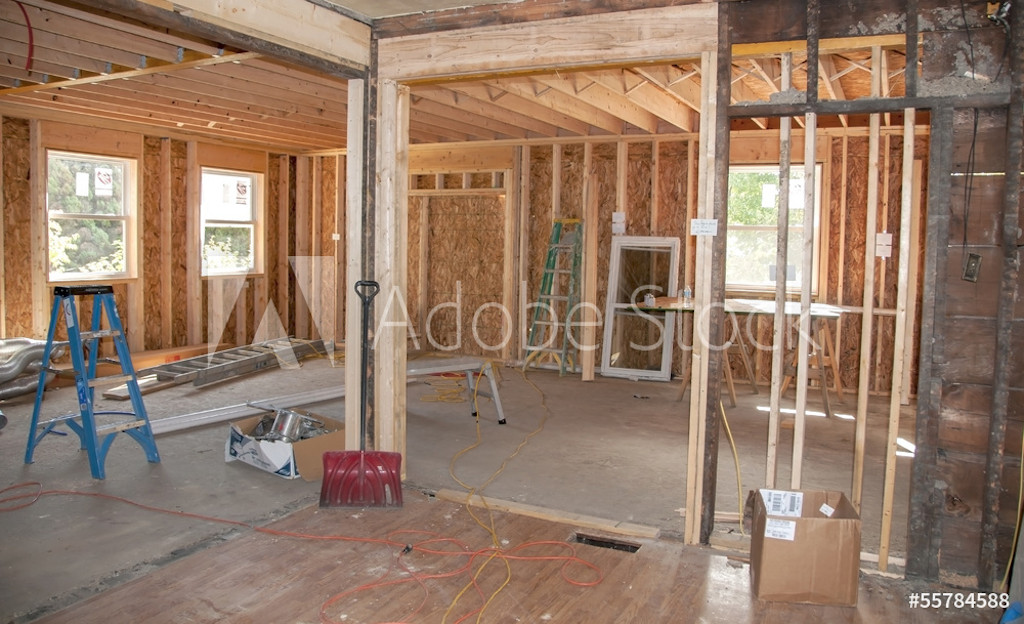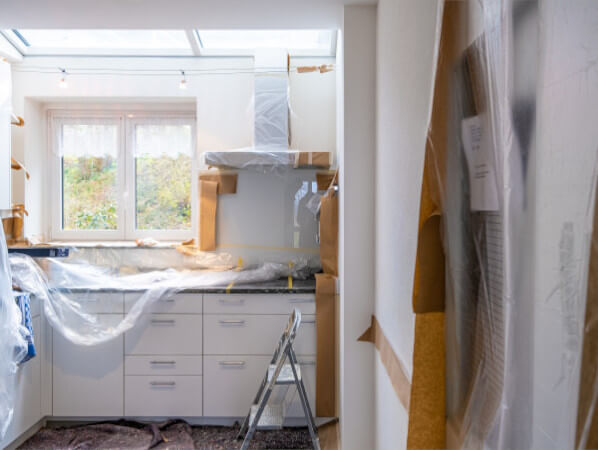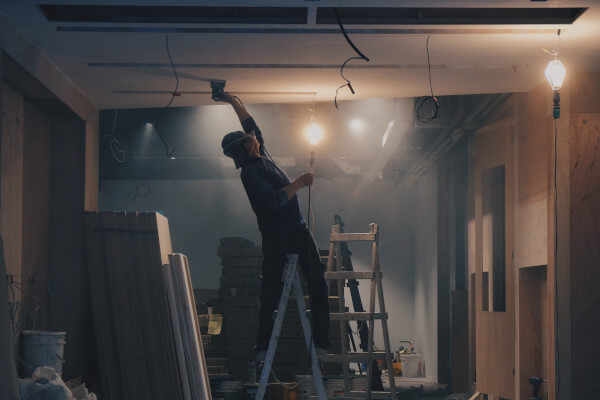5 Things to Know Before You Begin a Property Renovation Project

Change is an inevitable part of all aspects of life- and our home lives are no exception. As we spend so much of our time in our homes (even more so due to the ongoing pandemic), it’s no wonder we look for change in terms of interior design and in the structure of our properties. From lifestyle changes- such as starting a family which requires interior change and perhaps change to the exterior, to modernising a home, a new theme or style- home renovations are something all homeowners will do at least once in their life. Renovating your property can be a challenging experience, however the transformational change to your home can be rewarding. Each property renovation task you undertake will bring new challenges and unexpected twists, and there are plenty of tips and tricks that can help if you find yourself in a sticky home renovation situation. Additionally, home renovations are a great way to add value to the cost of your property, as it enables you to adjust your home to the property market, therefore making it more desirable while adding value onto the property. If you’re wondering “how can I sell my house fast?”, then home renovations are a perfect place to start. But before you begin, here at We Buy Any House have compiled a list of things you should know before you begin a property renovation project.
Start With a Building Survey:
Before renovating any part of your property- you should commission a chartered building surveyor. This is especially important if you are planning on doing any structural renovations, such as building an extension or doing a loft conversion. The price of a surveyor typically ranges from £500 to over £1,000, depending on the age, size and location of the house. However, they will highlight important issues such as problems with the roofing, damp or any structural movement- which can cause major damage if not assessed properly.
Budgets and Quotes:
We all love to indulge in home-makeover TV shows- however they aren’t the greatest advisor when it comes to renovating your own home in terms of budget and expenses. It’s important that you don’t underestimate the cost of your renovation project, as this may result in you taking loans from the bank and ending up in financial hardship. Instead, before your project commences, sit down with your family/partner and work out how much things will cost- down to the last little details. Then, put some extra money aside in case anything goes wrong as an emergency fund.
Another thing to do is ask for an accurate estimate. Don’t trust the valuation of one person, seek several experts in that field and get an average estimate of the cost for specific jobs. Additionally, don’t rely on a ‘textimate’ (over the phone estimate). Encourage the person to come and view your property in person, so they can see what they’re dealing with firsthand.
Create a Realistic Timeline:
In an ideal world, all renovation projects would be done at the click of a finger. However, unfortunately, in reality this isn’t always the case. It’s important to have a sense of realism about home renovation projects and understand that even though you have probably been given a rough estimate by contractors, there may be factors which implicate this. Prepare for things to take longer than assumed and try to avoid feelings of frustration by envisioning the finalised result. A tip to get around this is to order your new updates before you have the existing materials removed, so that there’s no waiting time.
Expect the Unexpected:
Midway through your home renovation, there may be an unexpected occurrence. Whether it’s regarding uneven floors due to a shifted center joist, a roofing problem or problem with your water system, this can have a huge impact on the time scale of the project. The renovations will stop, and you will have to source a specialist who can repair that specific issue- and then renovations will resume when the site is safe and legally sound. This is just one reason why it’s better to allocate extra time and money into your renovation project- so you are protected from unanticipated mishaps along the way.
Be Specific:
Time is money and money is time. Your home renovation will probably not be cheap, so its best to have a clear plan before you give the green light. Although things may crop up along the way, there are certain things that should be concrete throughout the process (no pun intended!). Where you plan for things such as your radiators to be positioned, sockets and lighting layout should all be thought of well in advance. After all, it’s you that will be struggling to use your phone whilst its charging. The same goes for interior design. Don’t be swayed by a designer that thinks they know your style and taste and want free reign (unless you’re comfortable and happy with this). Instead, pre plan the interior of your home, and if it can’t be an exact match, get something close.
How to Upgrade Your Bedroom with Small Tweaks
Upgrading your bedroom is something of a dream. We all know how wonderful it feels to step into a freshly decorated space, featuring beautifully designed soft furnishings, elegant colour schemes and show stopping finishing touches. We have the perfect advice for you and your home, adding the building blocks to a complete, fresh, new interior style.
The smaller details really make a difference when upgrading your space. From switches to plug sockets you can combine contrasting yet complementing electrical features around your room to really add finesse. Often, we forget about upgrading our plug sockets and switches, underestimating the impact this has on your home, not only from a safety angle, but from an aesthetic perspective also. Our personal favourites are a smoked bronze or brass dimmer switch or toggle switch. For beautiful bedroom ambience, a dimmer switch is perfect for setting the evening tone.

Image Credit: Buster & Punch
For detailing around your headboard, introducing drop pendants either side of your bed to replace lamps and bedside tables is a perfect space saving technique whilst giving a luxe minimalist vibe throughout your bedroom. Controlling these each with separate dimmer switches allows you to create your own lighting either side of the room. Additionally, drop pendants make perfect reading lighting.
If the space in your room allows you to, you can create a coffee corner. This is a space featuring a beautiful bedroom chair and small table as an additional space to relax and unwind. Featuring a beautiful furniture piece in your room creates an eye-catching focal point to the room, adding character and definition. If your space is more neutral, you can introduce a pop of colour here as an elegant contrasting piece.
Let’s talk flooring. Flooring can transform your space entirely, and although it may not be considered a ‘small tweak’ it shows how something so simple can have a huge impact on the look and feel of a room. We absolutely adore a soft carpet in your comfort spaces such as a snug, office, or living room, and bedroom, the warm comforting touch on the soles of your feet is enough to bring anybody pure comfort. In a hallway and kitchen our top favourites are a herringbone style hardwood flooring or a neutral tile. The beauty of this being the ease of use and cleaning whilst featuring a crisp and clean finish.
Lastly, your soft furnishings play a huge part in the design of your bedroom. More specifically here, your curtains and blinds. If you’re looking to keep the light out, consider a roman blind paired with thick, luxurious, lined curtains for added comfort. Nothing breaks a room up more and adds character better than beautifully designed curtains. For the more luxurious feel, consider a silver lined pleated curtain or other neutral metallic shades.
How to Choose Paint Colors for Your House

Are you ready to update your house? There are plenty of home improvements you can make, big or small, that are sure to leave an impact. If you’re looking to refresh your house with paint, the first thing you have to do is choose some potential colors. Easier said than done, right? Selecting a color palette for your home can seem like a daunting task because of the endless options out there.
Here’s the best process for choosing paint colors for your home.
Pick out a few color options. The first step in deciding which color(s) are suitable for your home is to choose a few different colors. It sounds silly, but this first step is crucial on the path to deciding which color is right for you. You’ll narrow down the options without completely settling on one particular color from the start. Then, consider the space you’re looking to paint — is it indoors or outdoors? What does the furniture look like? Is there a lot of natural light in the room? Are there any colors or color families you can’t stand? What colors make you happiest? The answers to these questions will point you in the right direction for the next steps.
Know a little color theory. Consider your reason for having your home painted. Is it to make your home look bigger? Perhaps it’s so your home can feel cozier. Whatever your reason for painting is, there’s a paint color to match your goal. Generally speaking, crisp whites can help open up a space, but these hues can also make a room feel cold and lifeless. On the other hand, warm colors can make any space in a home feel welcoming, while soothing cool pastels can make a space more relaxing. Think about the atmosphere you’re trying to create and let that inspire your color choices.
Test multiple paint swatches. Whether you’re painting indoors or outdoors, professional house painters in Ashland, MA, say it’s always a good idea to do a color swatch test before making the final decision. You can easily get a sample size of the color you’re considering from a local paint or hardware store. When you swatch, make sure to test the color in multiple areas, so you get a good idea of how the color looks in shadow versus how it looks in the light. Additionally, make sure to swatch a large enough space (about a one-foot by one-foot area will do), so you have a better idea of how the color will look when you commit.
Use an online color visualizer. Perhaps the most challenging part of choosing a color for the interior or exterior of your home is knowing what it will look like when the job is done. Color swatching can get you pretty far, but you still won’t know what the finished product will truly look like. Fortunately, there are a variety of free tools online that can help you picture any color in your space. All you have to do is upload photos of your room, choose the color you’re considering, and the visualizer will provide you with a picture of your revitalized space.
Decide on a paint finish. One of the last steps in choosing a paint color for your home is settling on the type of finish you want. Most paints are available in flat, matte, eggshell, satin, semi-gloss, or high-gloss. The space you’re having painted can help determine the finish you choose, as can your personal preferences. Homeowners often opt for a long-lasting finish like eggshell or satin in high-traffic areas because it is scrubbable and can withstand the test of time. If you’re unsure which finish is right for you, a painting professional can provide you with more information.
And if you’re still stuck on what color paint to choose for your home makeover, it might be time for a consultation. Professional painters and interior decorators can usually make color recommendations for any space in your home. Remember that you don’t always have to go with what’s on trend. Follow your gut and choose the colors that make you feel the most content.
3 Tips for Decluttering Your Home
There are many reasons a person might decide to declutter their belongings. Perhaps they have an upcoming move approaching, they’re downsizing to a space with less storage, or they might simply be dreaming of a living space with a lot less stuff. In any case, they need to cut down on the items around them, getting rid of things they don’t need and taking advantage of more effective storage options for those items they intend to keep.
As you embark on your decluttering journey, you may run into a wide range of obstacles and even more questions. For example, how should you handle the sheer number of items you have to sort through? Where can you find storage units near you? What should you do with the things you’re purging? Fortunately, a few particular tips can guide you through the decluttering process at home and beyond.
1. Find the right type of decluttering for you.
From Marie Kondo to The Home Edit, there’s no shortage of decluttering and organizing methods you can choose from, and each one has its legions of devoted followers who swear by their strategy of choice. However, your question shouldn’t be which method of organizing or decluttering is the most effective for most people. Instead, you should consider which option is the right fit for you.
Hot Mess House host Cas Aarssen utilizes this concept in her Clutterbug ideology, a set of four different organizing styles she’s seen in her clients. The same principle can be applied to decluttering. For example, should you sort through your items in large groupings, like the KonMari categories of clothes, books, papers, and so on, or will you have better results by categorizing your belongings further, such as decluttering tops, bottoms, dresses, and other subcategories within the larger umbrella of clothing? Once you’ve determined the most effective strategy for your unique needs and personality, the decluttering process will become much less overwhelming.
2. Figure out what to do with your existing belongings.

The belongings you keep and those you decide to discard will need to be dealt with beyond this initial declutter. For those things you plan to keep, what will you be doing with them? Ideally, you’d have delegated spaces within your home for everything you keep. However, your space doesn’t always work with your lifestyle. For instance, what if you’re embarking on RV life and are decluttering your belongings to fit in that small space, but you don’t want to lose their cherished heirlooms or other non-urgent items just because they’re not in the RV with you? In these cases, a storage facility may very well be your best bet. Just be sure to organize your storage unit to make sure your items are indeed organized and decluttered.
3. Find ways to dispose of the excess.
There are other items that you won’t want to keep. It’s easy to toss out blatant trash, but other types of belongings might prove more difficult. Can that box be recycled? Where might you donate those old clothes? What should you do with that entire extra pile? Take some time to research how you should dispose of those items you’ve decluttered to ensure you’re doing so responsibly. Donations, trash, and even gifts can get unnecessary items out of your home or storage space and to a more appropriate destination.
When you stare at a pile of clutter, the sheer thought of purging and organizing can become intimidating. However, you can and will get through these items successfully. Simply spend some time considering the methods and minds that will work best for you, store your “keep” pile in an organized manner, and dispose of the decluttered excess responsibly. Then, enjoy your newfound extra space!
